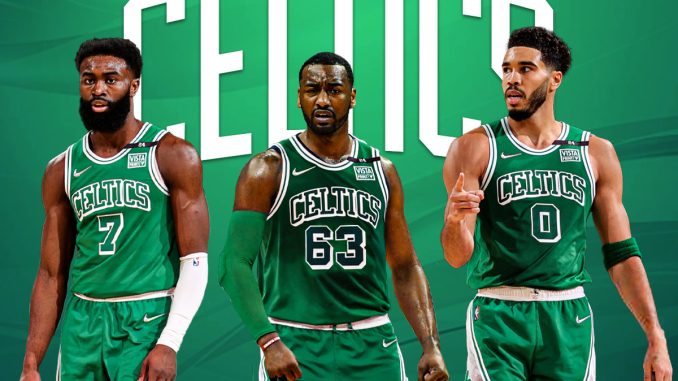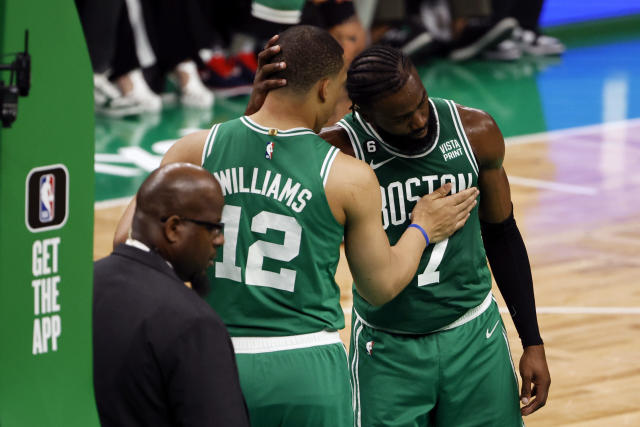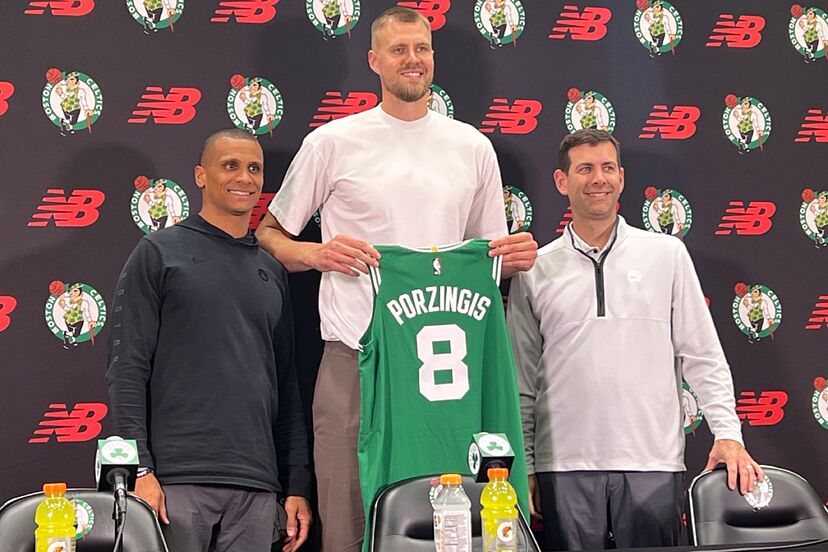
The Celtics aren’t entirely done filling out their roster. Brad Stevens told reporters Thursday in Las
Vegas he would still like to add wing or forward depth.

Stevens isn’t likely to have anything more than veterans minimum contracts to offer free agents but has a $6.3-million trade exception to seek
additional help.
He also has enough future draft capital to think about a bigger trade, but that could be a conversation for
another day.
In all likelihood, the Celtics have finished their biggest roster change for the coming season. They pulled
off a major shakeup early, sending Marcus Smart to Memphis in a trade that netted KristapsPorziņģis.
That move alone assured Boston’s rotation would look plenty different during the coming season. But
how different will it be?
That’s what I set out to discover when I mapped out my own version of the Celtics rotation. Obviously,
any further alterations would change my calculus, but it seemed like a good time in the offseason to take
stock of the current roster.
Before I unveil my projected rotation, please know this exercise is absolutely one of the more difficult
things I do each season. I hate myself every time I do it. While trying to come up with the perfect lineup
combinations, I scribble down notes, cross out a million ideas and repeatedly ask myself why I’m such a
moron.
Even after coming up with a somewhat passable rotation, I always have scathing questions for myself. This year, those included but were not limited to:
- Why is your pathetic behind refusing to play Payton Pritchard? Don’t you know he has actually been pretty good when given the chance and there should be more room for him now after the Smart trade?
- Why did you not find more minutes for the 7-foot-3 Porziņģis to play at center, you irredeemable fool?
- Hey, bozo, don’t you think Joe Mazzulla will close with Al Horford after doing so regularly this past season?
Mazzulla could. But for this exercise, I’m in charge. And I’m not kidding when I say that devising a
pretend rotation gives me far more respect for coaches worldwide.
I don’t need to live with the consequences of my lineup choices. I don’t need to wonder how the players I
leave on the bench will react to my decisions. I don’t need to worry about the locker room impact of
every single move I make. And, still, I hate that I didn’t find enough time for a bunch of different lineups,
including those with Porziņģis at center. I wanted to stay big because size could differentiate this Celtics
team, but I might have gone too big. Did I put enough ball handling on the court? Did I prioritize
toughness and fit enough?
I probably screwed up plenty of the small stuff. I’m sure I botched some of the big stuff. At least I now
understand a very small percentage of the pain Mazzulla and other NBA coaches go through while
coming up with a rotation each night. To anyone constantly ready to criticize coaches for not playing a
certain lineup or player enough, please know that piecing together the puzzle of an NBA rotation is a
brutal task.
So, why do I put myself through such suffering? Because building a rotation of my own can help
illuminate questions the team still needs to answer. Because it can help me see a potential vision for the
Celtics. Because it helps me understand the roster just a little bit better and I hope it does the same for
the readers.
Anyway, here’s the rotation I came up with followed by five of the biggest takeaways from the exercise.
Mazzulla could shift the lineup from night to night depending on matchups and situations, but this is
just one idea for a healthy Celtics rotation.
The takeaways
1. No Pritchard?
Brad Stevens has regularly included Pritchard on the list of players who should receive a bigger
opportunity with Smart gone. That suggests Pritchard is likely to play on a regular basis. At the very
least, he should be next in line for minutes whenever one of the perimeter players in front of him misses
time. The Celtics don’t have a load of backup wings right now. They don’t have an abundance of ball
handlers. Pritchard seems like a real part of Boston’s plans.

So, why didn’t I give him any time here? I just prioritized more size and athleticism. The Celtics should
give Derrick White more minutes now that Smart’s gone. They can get away with a guard rotation of just
White and Malcolm Brogdon if they give the rest of the perimeter bench minutes to Sam
Hauser and Oshae Brissett. I’m not entirely sure the Celtics would have enough ball handling the way I
set everything up, but Pritchard doesn’t actually run the offense very often anyway. In my brain, which
admittedly fails to work at least 60 percent of the time, I decided the defensive benefits of extra length
would outweigh the positives of Pritchard’s accurate shooting and constant movement.
Was I right? Maybe not. The Celtics could decide they need another guard on the court. Pritchard’s lack
of size probably won’t matter as much when Porziņģis and Robert Williams are behind him. Pritchard
could beat out Hauser and/or Brissett for minutes. Mazzulla could go several different ways with his
bench. But maybe it’s instructive that I went into this exercise thinking Pritchard would likely be a part
of the everyday rotation and walked away from it thinking, “Ah, I don’t know, maybe not.”
(Of course, the Celtics will need Pritchard if Brogdon’s not right physically. But Stevens said on draft
night that he’s “very confident” Brogdon will be fine.)
2. The Celtics’ size could kill
One major factor in my call to keep Pritchard out of the rotation: The acquisition of Porziņģis gives the
Celtics a chance to be enormous all over the court. I leaned into that identity.
Stevens has regularly said he believes Porziņģis will fit well next to either Horford or Williams. During a
recent interview with Celtics.com, Stevens even brought up the wild idea of Porziņģis playing small
forward alongside the other two big men. Do I think the Celtics are likely to use that zany lineup much, if
at all? No. But I think it’s probably wise to listen to the boss man when he said the Celtics wanted to
swap out one of their guards for a big man because they wanted to rebalance the roster. That tells me the
idea is to put more size on the court — a lot of size.
I ran with that idea. If the Celtics start the group I think they will, their first unit’s average height will be
6’8.5”. I could have featured a bit more size with bench lineups but wanted to limit the minutes of
Horford (who is 37 years old) and Williams (who has a lengthy injury history). Porziņģis also has health
issues in his past but played about 32 minutes per game last season. Boston should ask him to do the
same. I probably didn’t play him enough at center in this exercise (just a couple of minutes per half), but
that’s only because it was tough to do so while finding enough minutes for both Horford and Williams.
Mazzulla, the Celtics’ actual coach, could want to right my wrong there. The Porziņģis-at-center lineups
should have a whole lot of offensive juice.
The other lineups could be dominant defensively. Though the Celtics lost Smart, the 2022 Defensive
Player of the Year, they should have far more rim protection than they did one season ago and plus-size
at every position. Boston gave up substantial defensive versatility but did so to build one of the biggest,
blocking frontcourts in basketball. Though the losses of Smart and Grant Williams could limit Mazzulla’s
strategies come playoff time, the guess here is that Boston’s defensive numbers won’t suffer much, if at
all, at least during the regular season. Porziņģis ranked as one of the league’s best rim deterrents last
season and now has much more defensive talent around him.
The Celtics won’t always be their most enormous. Though I included all three big men in this rotation,
I’m sure the team will do some load management throughout the season. When regulars sit, I expect the
Celtics to play smaller lineups more frequently with Pritchard, Hauser and Brissett landing more
opportunities. But, when everyone’s available, I expect Mazzulla to turn to some giant lineups. The
Celtics will be huge with plenty of shooting. That should be a good combination if they don’t miss the
passing and toughness they lost too much, but they could certainly miss it. Their style will shift without
Smart.
3. White’s a point guard now – and a closer
White only played 21 percent of his minutes at point guard last season, according to Cleaning the Glass.
That’s his primary position now.
Sure, Tatum and Brown will handle the ball a lot. The Celtics will run some offense through Porzingis.
They won’t just ask White to run constant pick and rolls, but he should be in charge of the offense more
often. That typically worked out well last season; the Celtics smashed opponents by 15.7 points per 100
possessions with White at point guard, according to Cleaning the Glass’ position estimates. That has
been a deadly look for the team since he arrived in Boston, but there’s less margin for error now with
Smart in Memphis. The Celtics placed their bet that White will be ready for the new responsibilities. He
didn’t always close games last season, but I would be shocked if he’s not a regular in that role now. In my
rotation, he would play four more minutes per game than he did last season.
4. Who else should start? And close?
In my head, at least, the Celtics have four spots in their starting lineup and closing lineup settled already.
White, Tatum, Brown and Porziņģis should all be part of both groups. The fifth spot will probably be up
for grabs – and Mazzulla will have options.
In all likelihood, he will mix and match the fifth piece of the closing lineup depending on circumstances.
If the Celtics want to go small, they can throw Brogdon next to White and use Porziņģis at center. If they
want to go big, they can throw either Horford or Williams into the final spot and slide Porziņģis over to
power forward. I put Williams into the closing lineup because, after a healthy offseason, I think he’ll be
ready to claim that role. When deciding on that spot, I considered all of the success Porziņģis had next
to Daniel Gafford, another athletic center, last season. The Porziņģis-Williams duo could end up thriving
on both ends of the court.
I still started Horford, whose presence will give the Celtics first unit shooting across the court. But
Mazzulla could potentially go with Williams in the starting lineup instead. Either way, Mazulla should
have some fun experimenting with his retooled frontcourt.
5. How much will Grant Williams be missed?
The decision to move on from Williams helped Boston avoid some of the harsh restrictions of the
collective bargaining agreement’s second apron, but it also left a lack of forward depth behind Tatum
and Brown. That probably shouldn’t be too much of a regular-season issue when the Celtics are healthy.
Hauser has proven he can handle consistent minutes, and Brissett should replace some of the defensive
versatility Williams took with him to Dallas. Hauser and Brissett should be fine during the regular
season.
Will they cut it during the playoffs? That’s to be determined. Brissett, who shot 31 percent from the 3-
point arc last season, could be an offensive issue. Hauser could be a problem at the other end of the
court. Jordan Walsh, Boston’s second-round pick, is probably a long shot to earn any sort of consistent
minutes, never mind a playoff role. The Celtics could eventually regret losing Williams mostly for
financial relief and improved roster flexibility.
That’s a concern for another time. On paper, in the middle of July, the Celtics rotation looks pretty darn
good.
Leave a Reply